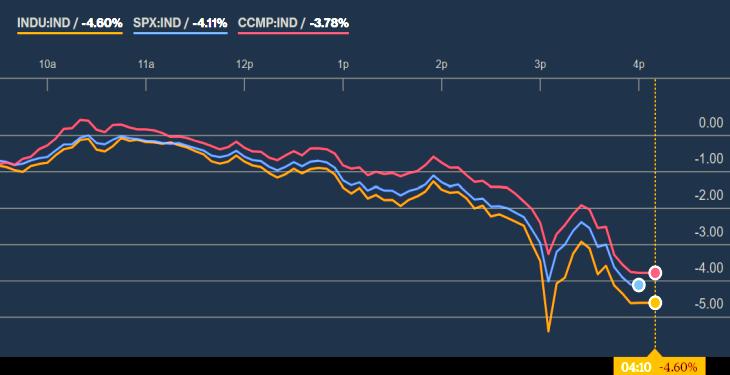The Dow Jones industrial average dropped 1,175 points on Monday, it’s largest point-drop in history, and its worst day in six years. The Standard & Poor’s 500 index, the benchmark most professional investors use, lost 113 points. The Nasdaq composite fell 273 points, or 3.78 percent, below 7,000 points. All three major US index are still strongly up for the last 12 months (15,5%, S&P 500, 21,41% Dow Jones, 23% Nasdaq).
On Tuesday, Japan’s benchmark Nikkei 225 tumbled 4.7 percent and the South Korean Kospi shed 1.54 percent, while Hong Kong’s Hang Seng index sank more than 5 percent.
The Dow Jones industrial average briefly plunged nearly 1,600 points Monday as two days of steep losses for U.S. stocks brought an end to a period of record-setting calm in the market. The Dow recouped about half that loss within minutes, but its gains for the year were still gone as of late afternoon.
The slump began on Friday as investors worried that creeping signs of higher inflation and interest rates could derail the U.S. economy along with the market’s record-setting rally. Energy companies, banks, and industrial firms are taking some of the worst losses.
Investors are worried about evidence of rising inflation in the U.S. Increased inflation might push the Federal Reserve to raise interest rates more quickly, which could slow down economic growth by making it make it more expensive for people and businesses to borrow money. And bond yields haven’t been this high in years. That’s making bonds more appealing to investors compared with stocks.
The stock market has been unusually calm for more than a year, writes an Associated Press commentary. The combination of economic growth in the U.S. and other major economies, low interest rates, and support from central banks meant stocks could keep rising steadily without a lot of bumps along the way. Experts have been warning that that wouldn’t last forever.
David Kelly, the chief global strategist for JPMorgan Asset Management, said the signs of inflation and rising rates are not as bad as they looked, but after the market’s big gains in 2017 and early 2018, stocks were overdue for a drop.
“It’s like a kid at a child’s party who, after an afternoon of cake and ice cream, eats one more cookie and that puts them over the edge,” he said.
As bad as Monday’s drop is, the market saw worse days during the financial crisis. The Dow’s 777-point plunge in September 2008 was equivalent to 7 percent, about twice as big as Monday’s decline.
The market hasn’t gone through a 10 percent drop since early 2016, when oil prices were plunging as investors worried about a drop in global growth, which could have sharply reduced demand. U.S. crude hit a low of about $26 a barrel in February of that year.
Benchmark U.S. crude oil fell $1.30, or 2 percent, to $64.15 a barrel in New York. Brent crude, the standard for international oil prices, lost 96 cents, or 1.4 percent, to $67.62 a barrel in London.
Exxon Mobil lost $4.56, or 5.4 percent, to $79.97 and Chevron gave up $5.62, or 4.7 percent, to $112.96. Both companies reported disappointing fourth-quarter results on Friday and are coming off their biggest losses in years.
Gold declined 80 cents to $1,336.50 an ounce. Silver dipped 4 cents to $16.67 an ounce. Copper rose 3 cents to $3.22 a pound.
